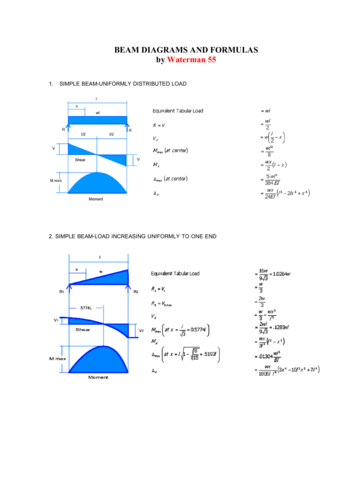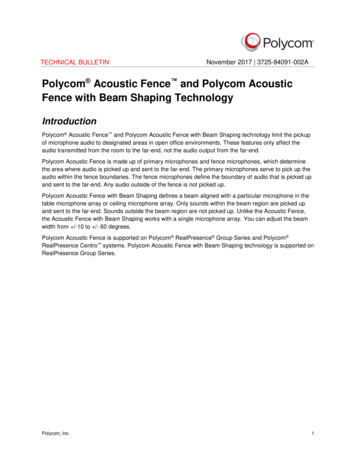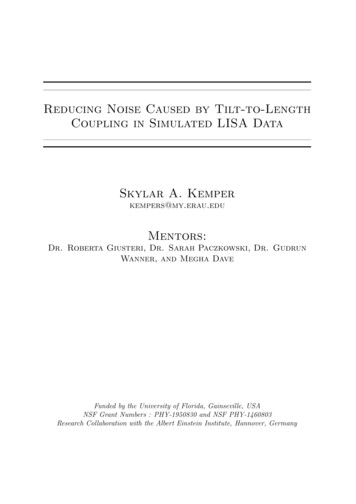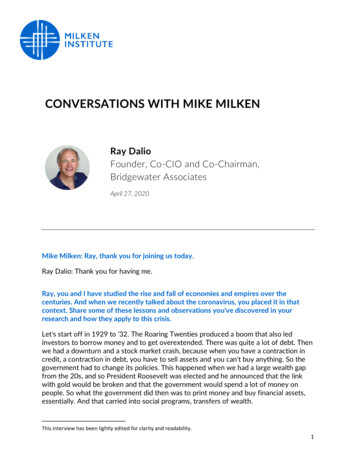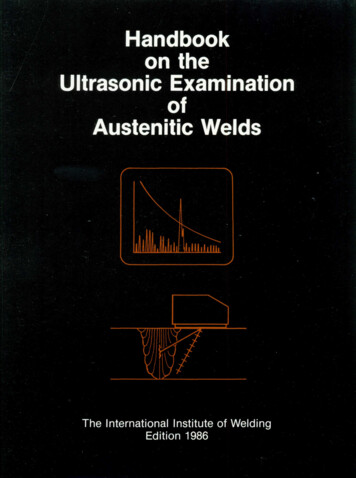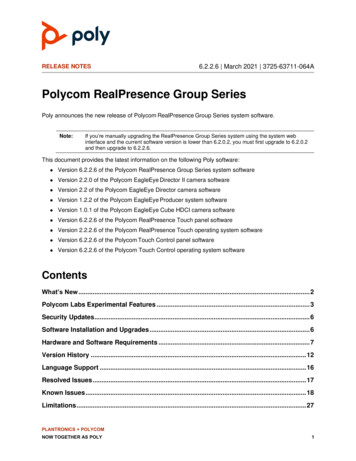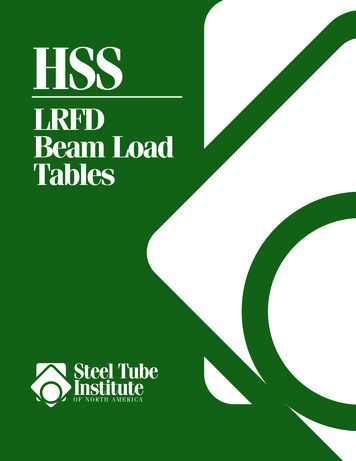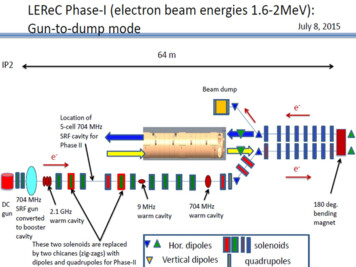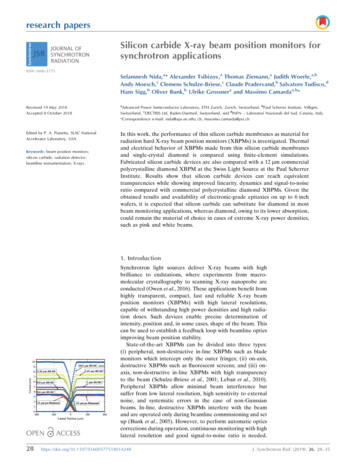
Transcription
research papersSilicon carbide X-ray beam position monitors forsynchrotron applicationsISSN 1600-5775Selamnesh Nida,a* Alexander Tsibizov,a Thomas Ziemann,a Judith Woerle,a,bAndy Moesch,c Clemens Schulze-Briese,c Claude Pradervand,b Salvatore Tudisco,dHans Sigg,b Oliver Bunk,b Ulrike Grossnera and Massimo Camardaa,b*Received 19 May 2018Accepted 8 October 2018Advanced Power Semiconductor Laboratory, ETH Zurich, Zurich, Switzerland, bPaul Scherrer Institute, Villigen,Switzerland, cDECTRIS Ltd, Baden-Daettwil, Switzerland, and dINFN – Laboratori Nazionali del Sud, Catania, Italy.*Correspondence e-mail: nida@aps.ee.ethz.ch, massimo.camarda@psi.chEdited by P. A. Pianetta, SLAC NationalAccelerator Laboratory, USAIn this work, the performance of thin silicon carbide membranes as material forradiation hard X-ray beam position monitors (XBPMs) is investigated. Thermaland electrical behavior of XBPMs made from thin silicon carbide membranesand single-crystal diamond is compared using finite-element simulations.Fabricated silicon carbide devices are also compared with a 12 mm commercialpolycrystalline diamond XBPM at the Swiss Light Source at the Paul ScherrerInstitute. Results show that silicon carbide devices can reach equivalenttransparencies while showing improved linearity, dynamics and signal-to-noiseratio compared with commercial polycrystalline diamond XBPMs. Given theobtained results and availability of electronic-grade epitaxies on up to 6 inchwafers, it is expected that silicon carbide can substitute for diamond in mostbeam monitoring applications, whereas diamond, owing to its lower absorption,could remain the material of choice in cases of extreme X-ray power densities,such as pink and white beams.Keywords: beam position monitors;silicon carbide; radiation detector;beamline instrumentation; X-rays.a1. IntroductionSynchrotron light sources deliver X-ray beams with highbrilliance to endstations, where experiments from macromolecular crystallography to scanning X-ray nanoprobe areconducted (Owen et al., 2016). These applications benefit fromhighly transparent, compact, fast and reliable X-ray beamposition monitors (XBPMs) with high lateral resolutions,capable of withstanding high power densities and high radiation doses. Such devices enable precise determination ofintensity, position and, in some cases, shape of the beam. Thiscan be used to establish a feedback loop with beamline opticsimproving beam position stability.State-of-the-art XBPMs can be divided into three types:(i) peripheral, non-destructive in-line XBPMs such as blademonitors which intercept only the outer fringes; (ii) on-axis,destructive XBPMs such as fluorescent screens; and (iii) onaxis, non-destructive in-line XBPMs with high transparencyto the beam (Schulze-Briese et al., 2001; Leban et al., 2010).Peripheral XBPMs allow minimal beam interference butsuffer from low lateral resolution, high sensitivity to externalnoise, and systematic errors in the case of non-Gaussianbeams. In-line, destructive XBPMs interfere with the beamand are operated only during beamline commissioning and setup (Bunk et al., 2005). However, to perform automatic opticscorrections during operation, continuous monitoring with highlateral resolution and good signal-to-noise ratio is J. Synchrotron Rad. (2019). 26, 28–35
research papersThis increases the quality of beam delivered to the endstationsand thus the quality of experimental data. To this end, nondestructive, in-line XBPMs are needed.The main drawbacks of in-line XBPMs are residual interference with the beam and degradation due to heat load andradiation. To minimize these drawbacks, transparency, hightemperature stability and radiation hardness are primaryrequirements for this category of monitors. Linearity and fastdynamics are also important to maintain a stable feedback.This has driven research in wide-band-gap semiconductors forradiation monitor applications (Schulze-Briese et al., 2001).Diamond is the material of choice among wide-band-gapsemiconductors due to its excellent transparency, radiationhardness and high thermal conductivity (Schulze-Briese et al.,2001; Smedley et al., 2011; Muller et al., 2012; Marinelli et al.,2012; Desjardins et al., 2014; Zhou et al., 2015; Williams et al.,2016; Griesmayer et al., 2016). Single-crystal diamond (scdiamond) as well as polycrystalline diamond on silicon (pcdiamond, or CVD diamond) XBPMs are now commerciallyavailable (DECTRIS, CIVIDEC). The desired device properties of sc-diamond are not obtained on a commercial scaledue to the use of thick substrates with high absorption, andavailability of samples only smaller than 10 mm 10 mm(Khmelnitskiy, 2015). Improving transparency by thinningdown the thick substrates and fabricating membranesencounters challenges. Reactive ion etching is tested butresults in too high ( 50%) thickness non-uniformity(Desjardins et al., 2014).A thin pc-diamond membrane grown on silicon is highlytransparent. However, polycrystalline material has defectsand grain boundaries that result in slow dynamics and nonlinearities (Bergonzo et al., 2006). The difference in thermalexpansion between a thin diamond film and a thick Sisubstrate also gives rise to wafer bowing, thereby limiting thewafer size to 3 inch (RIGI, DECTRIS). A high density ofdefects also reduces reproducibility hindering industrialization of the pc-diamond devices.XBPMs made of silicon carbide would provide high thermalconductivity and inertness as their diamond counterparts(Desjardins et al., 2014). Furthermore, electronic-grade singlecrystal 4H-SiC wafers with much lower defects densities thandiamond are available up to a diameter of 6 inch, avoiding thebottlenecks of diamond technology. Thus, this technologicallymature wide-bandgap material shows great promise for nextgeneration industrial XBPMs.Nevertheless, due to difficulties in fabricating micrometrethin active layers, 4H-SiC has never been considered as acandidate for XBPMs. Recently, it was shown that electrochemical etching in HF-based solutions could selectivelyremove the highly doped 4H-SiC substrate with an etch stopon the low-doped epitaxial layers (Dahal et al., 2017). Thismethod is used in our study to fabricate XBPMs on thinepitaxial membranes on 4H-SiC substrates. Fabricated devicesare then tested and compared with a commercial 12 mm pcdiamond XBPM at the Swiss Light Source (SLS) at the PaulScherrer Institute (PSI). The theoretical thermal and electricalbehaviors of diamond and 4H-SiC XBPMs are described inJ. Synchrotron Rad. (2019). 26, 28–35the next section followed by the experimental results on thefabricated devices.2. Device simulations2.1. Thermal simulationsDiamond exhibits a high transparency to X-ray beams, andhas a large thermal conductivity as well as low thermalexpansion coefficient. As a result, it withstands high-brillianceX-ray beams with minimal degradation. 4H-SiC, on the otherhand, has about ten times the absorption (650 versus 70 mmattenuation length at 8 keV) and half of the thermal conductivity of diamond (3.7 versus 22 W cm 1 K 1) (Henke et al.,1993; Yu et al., 2001). Because of this, it is important toinvestigate the thermal response of 4H-SiC XBPMs underhigh-brilliance pink beams from synchrotron light sources andfree-electron lasers (XFEL) to assess their reliability in thedifferent applications.COMSOL 5.3 (COMSOL Multiphysics; https://www.comsol.com) is used in this report to calculate the thermo-mechanicalresponse of a full chip, sensor plus packaging, under differenthigh-brilliance beams. The fully packaged device considered inthis study consists of a 1 mm sapphire plate, the XBPM and a1.2 mm Rogers RO4003 printed circuit board (PCB) forreadout [see Fig. 1(a)]. The entire bottom of the sapphire plateFigure 1(a) Components of the full chip: the XBPM device, a sapphire plate,which is in contact with a water-cooled copper plate, and the printedcircuit board (PCB). The PCB is placed on top for connections towardsthe XBPM and the readout system. (b) Simulated temperature profileacross the 4H-SiC XBPM with the beam centered at the origin. As can beseen, already at 375 mm, the temperature drops below 100 C.Selamnesh Nida et al. SiC X-ray beam position monitors29
research papersis in contact with a water-cooled copper plate held at 20 C. A5 mm 12 mm opening is made in the sapphire plate for thebeam. However, as can be seen in Fig. 1(b), the temperaturealready reaches 100 C within 500 mm, i.e. within the 4H-SiCsubstrate. All other surfaces are assumed to be fully insulatedto represent a standard operation in vacuum.To compare the temperature profiles of 4H-SiC anddiamond under equivalent transparencies, a 10 mm- and1.075 mm-thick membrane is assumed for diamond and 4HSiC, respectively (Henke et al., 1993). Ideal thermal andmechanical parameters of 4H-SiC, diamond, sapphire and thePCB are considered for the simulation. In the case of 4H-SiC,the reduction of thermal conductivity at higher temperaturesis incorporated, whereas device cooling through convectionand through surface emittance is not. These assumptions,which are verified in vacuum at low device temperatures,result in a general overestimation of the device temperature,which thus represents an upper limit for the experimentalconditions (Harris, 1995).As X-ray beam we assumed those of the OPTICS beamlineat SLS, which delivers a 100 mm FWHM Gaussian beam withtotal power density of 180 kW cm 2 corresponding to a powerof 18 W and a photon energy distribution between 4 keV and40 keV with a maximum at 15 keV. The absorption in 4H-SiCand diamond as a function of depth from the surface iscalculated asZ Absorption ðzÞ ¼ I Eph exp z Eph dEph ; ð1Þwhere I(Eph) and (Eph) are the beam intensity and attenuation length as a function of photon energy, Eph, respectively(Henke et al., 1993).As can be seen in Fig. 1(b), 4H-SiC shows a ‘hot-spot’ of700 C at the center of the beam. The peak temperature indiamond is much lower ( 10 ) due to its lower absorbedenergy density (same absorption, thicker material) comparedwith 4H-SiC. It is worth noting that the maximum temperatureobtained in 4H-SiC, 700 C, is still much lower than 1200 C, atwhich point the device would show intrinsic failure. Intrinsicfailure is where thermally excited carriers dominate and createa leakage path between the different pads of the XBPM. It isalso much lower than the melting point of the NiSi alloy(1300 C), which is used as a contact metal.Furthermore, we find a maximum volumetric strain of 0.6% and less than 200 nm membrane deflection; neither oftwo results is critical in terms of mechanical device reliability.Finally, the temperature at the contacts (pads and PCB) isfound to be below 100 C, so that 4H-SiC XBPMs should bestable and reliable even at such high operating temperatures.Nevertheless, further work is necessary to empirically provethe robustness of 4H-SiC XBPMs under such high-brilliancebeams.In the system considered, the removal of the heat generatedby the X-ray beam is achieved initially through the thinmembrane and then through the substrate in contact with thecooled sapphire plate. For this reason, the device temperatureincreases for increasing membrane size [see Fig. 2(a)] and30Selamnesh Nida et al. SiC X-ray beam position monitorsdecreases for increasing membrane thickness [Fig. 2(b)].Fig. 2(c) shows that a 4H-SiC XBPM on a 1.075 mm-thick and1 mm 1 mm large membrane can withstand up to 1.3 timesthe power density delivered by the OPTICS beam in focusedpink beam configuration before reaching intrinsic failure ofthe device.Figure 2Maximum temperature as a function of (a) membrane size, (b) thicknessof the membrane and (c) beam power density. When not swept, thesimulations assumed 1 mm 1 mm membrane size, 1 mm membranethickness and 180 kW cm 2 beam power density. For such a device andbeam characteristics, the absorbed power is 2.1% of the total beam powerdensity.J. Synchrotron Rad. (2019). 26, 28–35
research papersFigure 3Temperature profile over time considering a 1.4 mJ, 12.7 keV, 10 fs-longbeam with 50 mm FWHM, consistent with the ARAMIS SwissFELbeamline.Finally, for the case of fast and high-power XFEL beams,such as the ARAMIS SwissFEL which delivers 1.4 mJ at12.5 keV, 10 fs-long 50 mm FWHM ‘shots’ at 100 Hz, thetemporal profile of the maximum temperature is also investigated. Simulations are made in vacuum assuming theabsence of convective cooling. As shown in Fig. 3, thetemperature on the surface of the XBPM in the center of thebeam in such a case reaches a maximum of 1000 C during thefemtosecond ‘shot’ but relaxes back to 100 C within 80 ms. Themaximum temperature reached is, also in such a case, belowthe critical limit and, for a typical repetition rate of 100 Hz, the4H-SiC XBPM has enough time to cool down. The maximummechanical strain in this case is below 0.5%.2.2. Electrical/optical simulationsThe electrical and optical performance of ideal 4H-SiCand sc-diamond Schottky barrier diode XBPMs are simulatedusing a TCAD software from Synopsys. A two-dimensionalstructure is sufficient to simulate the main aspects of XBPMs,namely the charge collection efficiency and the positionsensitivity (which is related to the lateral resolution). AnX-ray beam with 8 keV energy, a photon flux of1 1012 photons s 1 and a FWHM of 100 mm is used for thesimulation. The ideal sc-diamond XBPM consists of a 10 mmthick nitrogen-doped (2 1014 cm 3) membrane with twoSchottky contacts on the two sides (see inset of Fig. 4). Abarrier height of 1.5 eV for a nickel contact is assumed at thecollector and the emitter. Two collector pads, separated by a6 mm gap, are placed on top and the emitter metallizationcovers the bottom. The device is simulated at 20 V bias.Diamond is highly transparent to X-ray beams with a tenthof the absorption coefficient of 4H-SiC (Henke et al., 1993).Therefore, to achieve the same transparency as a 10 mmdiamond at 8 keV, a 1.075 mm-thick 4H-SiC is used. A nickelSchottky contact to 4H-SiC with a barrier height of 1.5 eV isassumed for both collectors and the emitter (Itoh et al., 1995).J. Synchrotron Rad. (2019). 26, 28–35Self-consistent drift diffusion equations are solved forelectrical transport along with the transfer matrix method(TMM) for photogeneration and propagation of the beam.Optical generation here assumes that the energy of absorbedphotons is fully converted to excitation of valence electronswith an empirically determined ionization threshold of 7.8 eVin 4H-SiC and 13 eV in diamond (Bertuccio & Casiraghi,2003). This results in an effective quantum yield, the numberof electron–hole pairs generated per photon, of 1025 in 4HSiC and 615 in sc-diamond for an incoming X-ray beam ofenergy 8 keV. These carriers either recombine via theShockley–Read–Hall (SRH) process or are collected at thecontacts. The SRH model includes doping-dependent lifetimesin 4H-SiC whereas, due to the lack of proper model parameters, the lifetime in sc-diamond is assumed to be constant(Table 1). In 4H-SiC, generation of carriers due to impactionization is also taken into account by the Hatakeyamamodel (Hatakeyama, 2009). Material parameters used for thesimulation are listed in Table 1. It is important to note thatin diamond these values refer to the ideal high-purity scdiamond whereas real devices, especially pc-diamond, areexpected to perform significantly worse (Colbran, 2015).Simulation of the beam scan is performed by moving thecenter of a Gaussian beam across the XBPM. In a horizontalbeam scan, the photocurrent at the left collector goes frommaximum when the beam is fully under this collector tominimum when the beam is fully under the right collector(Fig. 4). The maximum current depends on the beam intensity,and the effective quantum yield and collection efficiency ofthe device. A good XBPM generates a larger number ofcarriers per photon as well as effectively separating themtowards the respective contacts before they recombine. It canbe seen that the maximum current is about 63% higher in 4HSiC than in sc-diamond. This difference is due to the difference in ionization energy, and thus effective quantum yield,between the two materials.Figure 4Collector current as a function of beam position for 20 V bias ofsc-diamond and 4H-SiC. Position 0 corresponds to the middle of thegap. The curves for both collectors are shown individually. The insetshows the cross section of the device (not drawn to scale; gap 6 mm,membrane ’ mm).Selamnesh Nida et al. SiC X-ray beam position monitors31
research papersTable 1Device parameters used for simulation.Optical parameters for both devices are from Henke et al. (1993) and electrical parameters for 4H-SiC from TCAD Sentaurus (2017). Material parameters for scdiamond not listed below are taken from the Ioeffe database ml).Parametersc-Diamond electronssc-Diamond holes4H-SiC electrons4H-SiC holesLifetime (ms)Saturation velocity(cm s 1)Mobility (undoped)(cm2 V 1 s 1)2 (Colbran, 2015)1.9 107 (Pomorskiet al., 2013)2000 (Colbran, 2015)2 (Colbran, 2015)1.52 107 (Pomorskiet al., 2013)2300 (Colbran, 2015)2.51.9 107 (Khan &Cooper, 2000)11100.51.9 107The position sensitivity, defined here by equation (2), is ameasure of the change in current as a function of the beammotion, dIdI R¼ ð2Þ dxRight dxLeft x ¼ 0 ðcenterÞwhere x is the position of the beam, with zero in the centerof the gap. The higher the position sensitivity, the smaller theresolvable beam movement. For a 100 mm beam under 20 Vbias, the position sensitivity of a 4H-SiC XBPM (47 nA mm 1)is about 67% higher than that of a sc-diamond XBPM(28 nA mm 1).To better understand the effect of bias on position sensitivity and collection efficiency of XBPMs, the actual devicestructure used in our experiments, a 4H-SiC p–n junctiondiode [inset of Fig. 5(a)] is also added for comparison.The collection efficiency of the three different structures ispresented in Fig. 5(a). Both sc-diamond and 4H-SiC Schottkydiodes need about 800 mV to gain 90% collection efficiency.This is because a bias is needed to drift carriers into thecontacts. On the other hand, thanks to its built-in electric field,the p–n junction is able to collect its maximum efficiencyat zero applied voltage. But this benefit comes at a cost ofa degradation of the collection efficiency due to incompleteseparation of the generated carriers in the heavily dopedp layer.When comparing the position sensitivity of the threestructures, we see that the 4H-SiC Schottky diode has a 67%higher signal than the sc-diamond XBPM due to the lowerionization energy. However, the lower collection efficiencyand slightly higher recombination in the p region results inonly about 27% higher position sensitivity of the pn-junctioncompared with the sc-diamond.113.5 (Hatakeyama et al., 2003)electrochemical etching. Different membrane thicknesses areachieved with further dry etching in SF6 /Ar plasma.Electrochemical etching (ECE) is an oxidation/oxideremoval process obtained by dipping silicon carbide samplesin an HF solution and electrically supplying holes for theoxidation through the back metal contact (Dahal et al., 2017;Watanabe et al., 2011; Gautier et al., 2012, 2013). The process iscapable of removing highly doped ( 1 1018 cm 3) p-typeand n-type layers but is selective towards low-doped n-typelayers (selectivity 1000 : 1 with respect to 5 1013 cm 3doped layers). This allows the thick highly doped substrate to3. Device fabrication4H-SiC XBPM devices are fabricated on wafers with epitaxiallayers grown on 375 mm 1 1018 cm 3 n-type substrates. Theepitaxial layers are either 2 mm- or 10 mm-thick 5 1013 cm 3n-type with a 0.5 mm 1 1018 cm 3 p-type as a top layer.The four-quadrant monitors are fabricated with reactive ionetching (RIE) in SF6/argon plasma to remove the p-type layerwith deposited metals as an etching mask. The etching maskis then used as an electrical contact to remove substrates via32Selamnesh Nida et al. SiC X-ray beam position monitorsFigure 5(a) Influence of the bias on collection efficiency for a beam position underthe electrodes. The inset shows the device architecture (not drawn toscale). (b) Influence of the bias on position sensitivity.J. Synchrotron Rad. (2019). 26, 28–35
research papersbe selectively removed, realizing membranes with thicknessesand uniformities as determined by the epitaxial layers.In this study, to evaluate devices with different thicknessesstarting from only two epitaxies, some devices are furtheretched using a standard RIE SF6 /Ar process. This allowed usto obtain devices with thicknesses down to 0.6 mm (0.5 mm ptype plus 0.1 mm n-type), as determined from the etching rateof the process. Consistent with the commercial pc-diamonddevice used for comparison (RIGI, DECTRIS), a 6 mm gapseparated the four front electrodes [cross section shown in theinset of Fig. 5(a)].4. Measurement resultsMost of experimental tests are conducted at either the X06SAor at the OPTICS beamlines of the SLS at the PSI in Switzerland. Beam widths between 50 and 200 mm in both verticaland horizontal direction are obtained by two collimator slitslocated 5 mm before the XBPM. Transmission through theXBPMs is determined by comparing the current of a 300 mmHamamatsu silicon diode monitor 35 cm downstream of theXPBM with and without the XBPM intercepting the beam.Motorized translation stages enabled precise movement of theXBPM in two orthogonal directions (x, y) transverse to thebeam. The rear-side contact of the XBPM is biased and thecurrent signals from the quadrant electrodes are measuredby a four-channel electrometer (AH501D from CAENELS).Unless indicated otherwise, all measurements described beloware performed with this configuration.Fig. 6(a) shows the beam transmission as a function of thebeam lateral position for the 1.24 mm 4H-SiC and a 12 mmcommercial pc-diamond XBPM device supplied by DECTRISat 8 keV beam energy. Within the measurement error,systematic plus random, estimated to be 2 nA, equivalent to 5% transmission error, we observe a well defined membraneregion in both devices. The transmission on the 4H-SiCmembrane is 95%, compared with regions of the samplewith the substrate where the transmission is below 30%. The12 mm pc-diamond and 1.24 mm 4H-SiC XBPM have similartransmission within experimental error.We subsequently analyse the electrical response of the 4HSiC XBPM as compared with that of the pc-diamond. In thecase of 4H-SiC, the built-in bias of the p–n junction in 4H-SiCachieves saturated charge collection at zero external bias,consistent with device simulations [Fig. 5(a)]. On the otherhand, saturated collection efficiency is achieved in pc-diamondonly for biases greater than 20 V due to lifetime killing defects.Without these defects, sc-diamond requires only 2 V toachieve saturated collection [Fig. 5(a) and Desjardins et al.(2014)]. Given the above result, all measurements on 4H-SiCXBPMs are performed at zero bias and, consistently withvendor specifications, we will always use 30 V for pc-diamond.Fig. 7 shows the electrical response of the 1.24 mm 4H-SiCXBPM in XY raster scan as compared with that of pcdiamond. Both devices show good uniformity, but the 4H-SiCXBPM shows a superior, more than four times higher, signalJ. Synchrotron Rad. (2019). 26, 28–35Figure 6(a) Transmission as a function of the beam lateral position for the 1.24 mm4H-SiC and 12 mm pc-diamond XBPMs using a 50 mm 50 mm beam at8 keV photon energy at the OPTICS beamline. The membrane shows97% and 94% transmission ( 5%) while the substrate is below 30 5%.(b) Charge collection efficiency for the 10.5 mm 4H-SiC and pc-diamondshowing 4H-SiC XBPMs collecting all carriers already at zero bias. Notethat a 10.5 mm 4H-SiC is used here to allow external biases comparablewith that used for pc-diamond.to-noise ratio. The noise level for both XBPMs was below themeasurement limit of 100 pA.The observed higher current signal for the 4H-SiC device ispartially due to the difference in electron–hole pair creationenergy of the two materials [7.8 eV and 13 eV for 4H-SiCand diamond, respectively (Bertuccio & Casiraghi, 2003)]and partially due to the difference in the charge collectionefficiency of the two devices (91% and 31% for the 4HSiC and pc-diamond, respectively, at 20 V, 12.4 keV,6 1011 photons s 1).Fig. 8 shows one-dimensional scans of a 100 mm X-ray beamalong the x-direction for 4H-SiC devices with differentthicknesses. Although all 4H-SiC devices show superior signaluniformity compared with pc-diamond, it shall be mentionedthat, in the case of the very thin 4H-SiC XBPMs ( 1.1 mm),no fully functional four-quadrant device was obtained. Thereason for such low yield can be the very thin low-doped nlayer, which prevents proper rectifying behavior.Finally, the response of the 1.24 mm 4H-SiC XBPM tovariations in the photon flux is analyzed. The dynamicSelamnesh Nida et al. SiC X-ray beam position monitors33
research papersFigure 8Current signal as measured from the different pads as a function of thebeam position scanning along the horizontal direction using a 50 mm 50 mm beam at 8 keV photon energy at the OPTICS beamline. Note thatthe 10.5 mm 4H-SiC XBPM signal is re-scaled to 20% of the actual valueto give the reader a clear overview of all XBPMs.Figure 7Current signal as measured from the different pads as a function of thebeam position for the (a) 1.24 mm 4H-SiC XBPM and (b) 12 mm pcdiamond XBPM using a 12.4 keV photon energy and 200 mm6 1011 photons s 1 flux beam at the X06SA beamline.response of the XBPM is analysed by opening and closing themechanical shutter of the X-ray beam whereas the currentresponse for different photon fluxes is studied by usingdifferent filters along the optical path. The 4H-SiC XBPMshows much faster dynamics (in the microsecond range,currently limited by the measurement setup) compared withpc-diamond (millisecond range) [see Fig. 9(a)]. In addition, itshows a linear response to photon flux for more than fourorders of magnitude, similar to a reference silicon diode[see Fig. 9(b)].5. ConclusionIn this paper, an extended simulation and experiments-basedcomparison between 4H-SiC and diamond XBPMs ispresented.Device simulations showed that, thanks to the lower electron–hole generation threshold energy, 4H-SiC has a potentially superior position sensitivity compared with even scdiamond XBPMs under equivalent transmission. They alsoshowed that, although 4H-SiC pin diodes can be operated atzero bias, they suffer from inferior charge collection efficiencydue to higher recombination rates in the p region and34Selamnesh Nida et al. SiC X-ray beam position monitorsFigure 9(a) Faster dynamics of the 4H-SiC XBPM (unbiased) compared with pcdiamond (biased at 30 V). (b) Linearity of 4H-SiC XBPMs in comparisonwith silicon diode. Both measurements are performed using a 12.4 keVphoton energy and 6 1011 photons s 1 flux beam at the X06SA/PX1beamline.J. Synchrotron Rad. (2019). 26, 28–35
research papersinferior position sensitivity due to the reduced thickness in thegap between the front collectors.Thermal simulations showed that even when the twomaterials absorb the same energy, with 4H-SiC at one-tenthof the thickness of sc-diamond, the higher absorbed energydensity in 4H-SiC results in a larger increase in temperature.However, this high temperature is found to be below thecritical operating temperature of 4H-SiC (1200 C) for thetwo experimental conditions: a 180 kW cm 2 (2.1% absorbedpower) focused synchrotron pink beam and a 1.4 mJ, 10 fs,12.4 keV monochromated XFEL beam, thus allowing applications of 4H-SiC even in the case of very high brilliancebeams.Preliminary experimental results based on the first fabricated 4H-SiC XBPMs compared with a commercial 12 mm pcdiamond device (RIGI, DECTRIS) showed uniform transparency across the device area. This excellent signal homogeneity shows the fabrication process to be suitable forproducing highly uniform 4H-SiC membranes. Homogeneousand highly transparent membranes are prerequisites forprecise beam-position monitoring and enable fast onlineposition stabilization procedures. In addition, superior signalto-noise ratio, linearity over four orders of magnitude of beamflux and faster dynamics ( 50 ms), at the limit of the currentmeasurement setup, is achieved. The added possibility ofoperating the 4H-SiC XBPM without external biases potentially simplifies the signal processing circuit.Given the obtained results and the maturity of this wideband-gap semiconductor, we expect silicon carbide to substitute pc- and sc-diamond XBPMs in most beam-monitoringapplications. Work is currently under way to further characterize 4H-SiC devices in terms of charge collection efficiency, radiation hardness and dynamics down to thenanosecond regime.ReferencesBergonzo, P., Tromson, D. & Mer, C. (2006). J. Synchrotron Rad. 13,151–158.Bertuccio, G. & Casiraghi, R. (2003). IEEE Trans. Nucl. Sci. 50, 175–185.Bunk, O., Pfeiffer, F., Stampanoni, M., Patterson, B. D., SchulzeBriese, C. & David, C. (2005). J. Synchrotron Rad. 12, 795–799.Colbran (2015). The Element Six CVD Diamond Handbook. ElementSix Technologies, https://www.e6.com.Dahal, R., Chowdhury, S., Hitchcock, C. W., Chow, T. P. & Bhat, I. B.(2017). Mater. Sci. Forum, 897, 379–382.Desjardins, K., Pomorski, M. & Morse, J. (2014). J. Synchrotron Rad.21, 1217–1223.J. Synchrotron Rad. (2019). 26, 28–35Gautier, G., Biscarrat, J., Valente, D., Defforge, T., Gary, A. & Cayrel,F. (2013). J. Electrochem. Soc. 160, D372–D379.Gautier, G., Cayrel, F., Capelle, M., Billoué, J., Song, X. & Michaud,J.-F. (2012). Nanoscale Res. Lett. 7, 367.Griesmayer, E., Kavrigin, P., Weiss, C. & Bloomer, C. (2016).Proceedings of the 5th International Beam InstrumentationConference (IBIC2016), 11–15 September 2016, Barcelona, Spain,pp. 71–74. MOPG1
polycrystalline diamond XBPM at the Swiss Light Source at the Paul Scherrer Institute. Results show that silicon carbide devices can reach equivalent . (Schulze-Briese et al., 2001). Diamond is the ma
